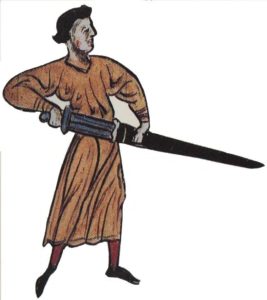Roger de Lacy twice conspired against the new king, William Rufus, who exiled him to Normandy and gave his property to Hugh de Lacy, Roger’s brother. When Hugh died around 1115, Ewyas Lacy was granted to Payne FitzJohn, who was married to Sybil, Hugh’s daughter (or niece). Henry I, however, took this opportunity to reallocate a large portion of the de Lacy’s vast estates and Payne and Sybil were left with about half of Hugh’s inheritance in Herefordshire, including Weobley. Payne remained Lord of Ewyas until 1137 when he met his death in a Welsh ambush. Sybil then married Jocelyn de Dinan, who was granted Payne’s estates.
During the civil war known as the Anarchy, Roger de Lacy’s son Gilbert fought to regain his father’s property and around 1148 he finally managed to recover his inheritance. The evidence from our research points to Gilbert being responsible for replacing the old wooden castle at Longtown with the stone castle that we see today. Between 1150 and 1160 a major redevelopment of the castle was undertaken which involved areas of the Green being demolished and taken back to bedrock, while large amounts of sandstone were being dumped near the south east corner. Clearly, a major rebuilding programme was under way.

Longtown Castle Green around 1200AD
At this time, a new metalled roadway was also laid out across the Green with new buildings alongside, made of clay or wattle and daub, probably with thatched roofs. Some of these may have been residential, but most appear to have been craftsmen’s huts and workshops. For the next hundred years, kilns, furnaces and metalwork forges were in operation, with even a possible windmill sited on the ramparts. Domestic activity was represented by cooking pot pieces, burnt animal bone, rubbish pits and latrines. Even a white gaming piece was found from this period and a spindle whorl for spinning wool.

spindle whorl

gaming piece
This was the hey-day of Longtown castle, presided over by Gilbert until 1160, his eldest son, Robert from 1160-62 and younger son, Hugh II de Lacy, from 1162-1186. At some point after the new castle was built, a borough was laid out at Longtown with a church dedicated to St Peter, a market place and regular-sized plots of land to be rented out to tradesmen and their families. Known as burgage plots, these were large enough for a house with workshops and space to grow food or keep a few animals. The burgage plots can be seen on the east side of the road up to the castle (see LIDAR picture below) but none appears on the west side, which suggests that the new borough may not have been a success.
 The de Lacys were immensely rich and became even wealthier when the second Hugh de Lacy, went with Henry II’s army to conquer much of Ireland in 1171. A formidable and energetic soldier and castle builder, Hugh expanded his influence to become the most powerful Norman baron in Ireland and effective Viceroy. Eventually, Henry II began to resent his wealth and power and when Hugh was murdered by one of his workmen during the construction of Durrow Castle, Henry was reported to be delighted.
The de Lacys were immensely rich and became even wealthier when the second Hugh de Lacy, went with Henry II’s army to conquer much of Ireland in 1171. A formidable and energetic soldier and castle builder, Hugh expanded his influence to become the most powerful Norman baron in Ireland and effective Viceroy. Eventually, Henry II began to resent his wealth and power and when Hugh was murdered by one of his workmen during the construction of Durrow Castle, Henry was reported to be delighted.

Contemporary depiction of Hugh(2) de Lacy by Giraldus Cambrensis
When Hugh died, his son Walter (the second of the name) was still a minor, so the de Lacy estates came into the custody, or wardship, of the Crown. This remained the case until 1189, when Walter came of age. All this was recorded in the Pipe Rolls for Herefordshire ‘in Wales’ by Ralph of Arden, the Sheriff of Hereford at the time, as was established practice for estates held in wardship by the Crown.
The 1187 entry records the sheriff’s accounting for £47 ‘of the land of Hugh de Lacy’ £37 of this was spent on the custody of the Castle of Ewyas and of the New Castle, with the remaining £10 spent on Weobley castle. A similar entry is made for the following year and for part of the year after. These sums would have been paid from rents collected locally and spent on the upkeep and garrisoning of the castles. The fact that the record includes Ewyas and New Castles in the one account of £37 is significant and shows that both castles lay within the same administrative area. Ponthendre, now shown to have been unfinished, cannot have been the Castle of Ewyas. Only two castles in Ewyas Lacy were rebuilt in stone. These were Longtown and later Llancillo on the border with Gwent. These were most likely the Castle of Ewyas and the New Castle.
Walter de Lacy had his inheritance restored when he came of age in 1189. With his younger brother, Hugh, he spent much of his early adulthood in Ireland consolidating his lands and granting charters to boroughs. However, relations between the de Lacys and the Crown, which had been difficult in their father’s time, remained a problem for the brothers. Much of this, it has to be admitted, was brought about by their own actions. Richard I, for example, confiscated Ludlow Castle, apparently for Walter’s ‘ravages on the King’s territory in Ireland’ and only restored it on ‘pain of 3,000 marks’ (about £2,000 or well over £1m in today’s money).
Things did not improve under King John, who succeeded to the throne in 1199. The de Lacy’s became embroiled in the dispute between William de Braose, another Marcher Lord, and King John. This started in 1207, led to open hostilities in 1209-10 and was not resolved until 1214. More fines and debts ensued but from this point on the de Lacy brothers remained loyal to the Crown and supported King John in the war with the Barons which resulted in the Magna Carta.
Walter became Sheriff of Hereford between 1217 and 1223 and it was during this period that he founded Craswall Priory. After 1223, his attention again turned to his Irish affairs which always seemed to end in trouble. After aiding his brother in a war against William Marshall for the control of Ulster, Walter was again fined 3,000 marks for going against the King’s intentions. From this point on his finances never recovered.

Longtown Castle gatehouse
In 1231, the Marcher castles were again put on a war footing, when Llewellyn ap Iorwerth (Llewellyn I) rebelled. Walter was ordered by Henry III to enlarge and strengthen the garrison at Longtown. It seems likely that this was when the western bailey dividing wall and gatehouse were built and the ramparts were heightened again. Pottery from this third phase of rampart building certainly dates from this time. The political situation was further complicated in 1233 by a short lived rebellion by some border barons, during which some castles, including Hay and Longtown, were occupied by the rebels. The short siege to free Longtown castle by Henry III’s army is the only recorded time that the castle was involved in conflict. At least one of Henry’s soldiers met his death there.
Walter’s last years were not happy ones. He died in 1241, blind and seriously in debt. His son was already dead, so the de Lacy estates were divided between Walter’s two granddaughters. Longtown lost its importance as a regional centre. In 1328 it was recorded that the castle was in ruins and the income from Ewyas Lacy shows a marked dip after 1350 when the Black Death ravaged many towns and villages across the country.
In 1403 Henry IV ordered Longtown to be refortified during the revolt by Owain Glyndwr. Nevertheless, the excavations showed that there was little activity on the Green after this date and soon afterwards the castle became the picturesque ruin we see today.
